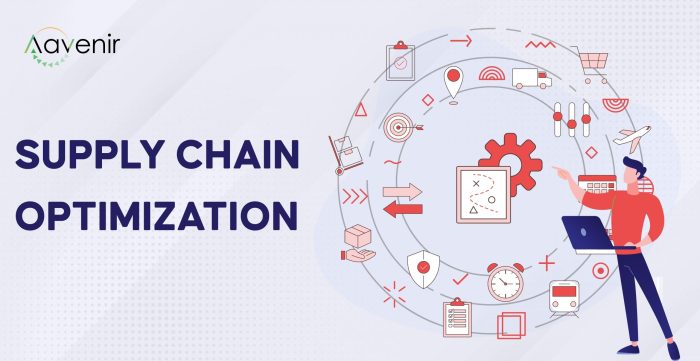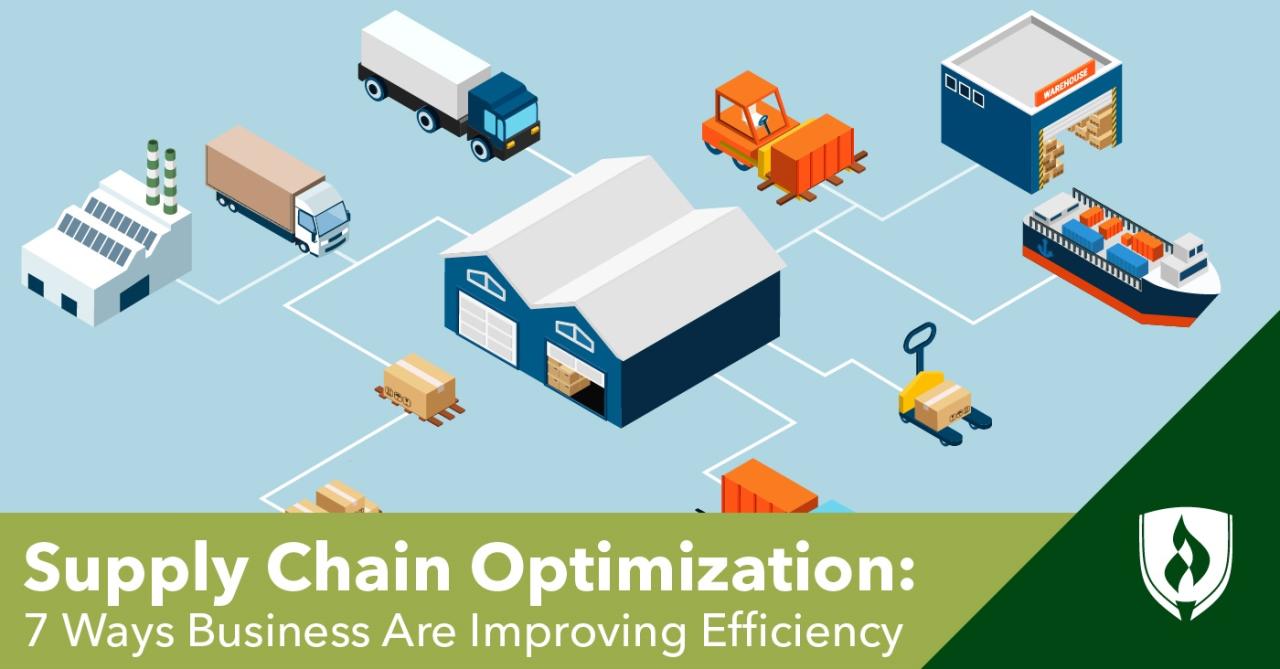
Efficient supply chain management is paramount in today’s globalized economy. Optimizing this intricate network—from sourcing raw materials to delivering finished goods—is no longer a luxury but a necessity for businesses aiming for profitability and sustained growth. This exploration delves into the core principles, enabling technologies, and future trends shaping the landscape of supply chain optimization, highlighting best practices and addressing potential challenges.
We’ll examine how artificial intelligence, machine learning, and blockchain are revolutionizing supply chain visibility and efficiency. Furthermore, we will explore risk mitigation strategies, sustainable practices, and the crucial role of key performance indicators (KPIs) in measuring success. The goal is to equip readers with a comprehensive understanding of how to build resilient, adaptable, and ultimately, optimized supply chains.
Defining Supply Chain Optimization

Supply chain optimization is the process of improving the efficiency, effectiveness, and resilience of a company’s supply chain. It involves strategically analyzing and redesigning every aspect of the chain, from sourcing raw materials to delivering finished goods to the end customer, with the goal of minimizing costs, reducing lead times, and enhancing customer satisfaction. This goes beyond simply streamlining processes; it requires a holistic approach that considers all interconnected elements and utilizes data-driven insights to make informed decisions.Supply chain optimization relies on several core principles.
These include leveraging technology to enhance visibility and collaboration, employing sophisticated forecasting techniques to anticipate demand fluctuations, optimizing inventory levels to avoid stockouts or excess inventory, and building strong relationships with suppliers to ensure reliable sourcing. Effective risk management is also crucial, mitigating potential disruptions through diversification, contingency planning, and robust communication networks.
Optimization Strategies Across Industries
Different industries employ various optimization strategies tailored to their specific needs and challenges. For example, the fast-moving consumer goods (FMCG) industry often uses just-in-time (JIT) inventory management to minimize storage costs and reduce waste. In contrast, the automotive industry might focus on optimizing logistics networks through efficient routing and transportation management systems to ensure timely delivery of parts to assembly plants.
The pharmaceutical industry prioritizes stringent quality control and regulatory compliance throughout its supply chain, requiring specialized optimization techniques to manage complex regulatory hurdles and ensure product safety. Each industry adapts optimization strategies based on its unique constraints and priorities.
Case Study: Zara’s Fast Fashion Supply Chain
Zara, a global fashion retailer, provides a compelling case study in successful supply chain optimization. Their vertically integrated model, with significant control over design, manufacturing, and distribution, allows for rapid response to changing fashion trends. They utilize advanced forecasting techniques combined with a highly responsive production system, enabling them to quickly adapt to consumer demand. Their proximity to suppliers and efficient logistics network contribute to shorter lead times and reduced inventory holding costs.
This responsiveness enables Zara to introduce new styles frequently, creating a competitive advantage and high customer satisfaction. This fast-paced, highly responsive system, however, requires significant investment in technology and infrastructure.
Key Performance Indicators (KPIs) for Supply Chain Optimization
Measuring the success of supply chain optimization initiatives requires the use of specific KPIs. These metrics provide quantifiable insights into the effectiveness of implemented strategies. Common KPIs include:
- Inventory Turnover Rate: Measures how efficiently inventory is managed and sold.
- Lead Time: The time it takes for a product to move from order placement to delivery.
- Order Fulfillment Rate: The percentage of orders fulfilled on time and in full.
- On-Time Delivery Rate: The percentage of shipments delivered on or before the scheduled date.
- Total Supply Chain Costs: Encompasses all costs associated with the supply chain, from procurement to delivery.
- Customer Satisfaction: A crucial indicator reflecting overall supply chain performance.
Tracking these KPIs allows businesses to identify areas for improvement and monitor the impact of optimization initiatives. Continuous monitoring and adjustments are essential to maintain a highly efficient and resilient supply chain.
Technologies Enabling Supply Chain Optimization

The effective optimization of modern supply chains relies heavily on the integration of advanced technologies. These technologies provide the tools and insights necessary to improve efficiency, transparency, and resilience across the entire supply chain network. This section will explore some key technologies driving this transformation.
Artificial Intelligence and Machine Learning in Supply Chain Optimization
AI and ML are revolutionizing supply chain management by automating processes, predicting future trends, and optimizing decision-making. AI-powered systems can analyze vast amounts of data from various sources – including sales forecasts, inventory levels, transportation routes, and market trends – to identify patterns and anomalies that would be impossible for humans to detect. This allows for more accurate demand forecasting, optimized inventory management, and proactive risk mitigation.
Machine learning algorithms can continuously learn and adapt, improving their accuracy and efficiency over time. For example, ML algorithms can be used to predict potential disruptions in the supply chain, such as weather events or geopolitical instability, allowing businesses to take preventative measures and minimize potential losses. Predictive maintenance, using AI to anticipate equipment failures and schedule maintenance proactively, is another significant application.
Blockchain Technology for Supply Chain Transparency
Blockchain technology offers a secure and transparent way to track goods and materials throughout the entire supply chain. By recording all transactions on a distributed, immutable ledger, blockchain enhances traceability and accountability. This increased transparency helps to combat counterfeiting, improve product quality control, and build trust among stakeholders. For example, in the food industry, blockchain can track the origin and journey of food products, ensuring consumers know exactly where their food comes from and how it was handled.
However, challenges remain, including the need for widespread adoption across the industry and the complexities of integrating blockchain into existing systems. Scalability and the cost of implementation are also significant hurdles.
Supply Chain Management Software Solutions
A range of software solutions are available to support supply chain management, each with its own strengths and weaknesses. These solutions typically incorporate functionalities for planning, procurement, inventory management, logistics, and execution. The choice of software depends on the specific needs and size of the organization. Some solutions focus on specific aspects of the supply chain, such as transportation management or warehouse management, while others offer a more comprehensive suite of functionalities.
The selection process often involves a careful evaluation of factors such as cost, functionality, integration capabilities, and vendor support.
Comparison of Leading SCM Software Platforms
| Feature | Software A | Software B | Software C |
|---|---|---|---|
| Demand Forecasting | Advanced statistical models, AI integration | Basic forecasting tools, limited AI capabilities | AI-powered predictive analytics, scenario planning |
| Inventory Management | Real-time inventory tracking, automated replenishment | Basic inventory tracking, manual replenishment | Advanced inventory optimization, integrated with procurement |
| Transportation Management | Route optimization, carrier selection, real-time tracking | Basic shipment tracking, limited route optimization | Advanced route optimization, dynamic routing, carrier management |
| Integration Capabilities | Seamless integration with ERP and other systems | Limited integration capabilities | Extensive API integrations, customizable workflows |
Supply Chain Risk Management and Optimization
Effective supply chain risk management is no longer a luxury; it’s a necessity for business survival in today’s volatile global landscape. Proactive identification and mitigation of potential disruptions are crucial for maintaining operational efficiency, financial stability, and ultimately, a competitive edge. This section explores a framework for assessing and addressing supply chain vulnerabilities, emphasizing the construction of resilient and adaptable systems.
A Framework for Identifying and Mitigating Potential Supply Chain Disruptions
A robust framework for supply chain risk management requires a multi-faceted approach. It begins with comprehensive risk identification, encompassing a wide range of potential disruptions, from natural disasters and geopolitical instability to supplier failures and cybersecurity breaches. This identification process should leverage data analytics, scenario planning, and expert judgment to create a prioritized risk register. Following identification, mitigation strategies are developed and implemented, focusing on reducing the likelihood and impact of identified risks.
Regular monitoring and review are essential to ensure the framework’s effectiveness and adapt to evolving circumstances. This iterative process of identification, mitigation, monitoring, and adaptation is key to building a resilient supply chain.
Best Practices for Building Resilient Supply Chains
Building resilient supply chains involves strategically diversifying sourcing, fostering strong supplier relationships, and investing in robust technology and infrastructure. Diversification reduces reliance on single suppliers or geographical regions, mitigating the impact of localized disruptions. Strong supplier relationships, built on trust and collaboration, ensure timely communication and problem-solving during crises. Technological investments, such as advanced analytics and real-time tracking systems, provide greater visibility and control over the supply chain, enabling proactive responses to emerging risks.
Furthermore, robust infrastructure, including redundant facilities and transportation networks, ensures continued operations even during disruptions. Investing in employee training and developing contingency plans are also crucial elements of a resilient supply chain.
Potential Risks and Mitigation Strategies
Understanding the types of risks and having mitigation strategies in place is critical. Below is a list of potential risks and corresponding mitigation strategies.
- Risk: Supplier bankruptcy or failure. Mitigation: Diversify sourcing, implement rigorous supplier selection and performance monitoring processes, develop strong supplier relationships, and establish backup suppliers.
- Risk: Natural disasters (earthquakes, floods, hurricanes). Mitigation: Diversify geographic locations of facilities and suppliers, implement robust disaster recovery plans, invest in resilient infrastructure, and secure appropriate insurance coverage.
- Risk: Geopolitical instability (wars, trade wars, political unrest). Mitigation: Diversify sourcing across multiple countries, monitor geopolitical risks closely, develop contingency plans for disruptions, and consider using alternative transportation routes.
- Risk: Pandemics (e.g., COVID-19). Mitigation: Develop robust pandemic preparedness plans, diversify sourcing, invest in technologies enabling remote work and communication, and build strong relationships with logistics providers.
- Risk: Cybersecurity breaches. Mitigation: Implement robust cybersecurity measures, conduct regular security audits, train employees on cybersecurity best practices, and develop incident response plans.
- Risk: Transportation disruptions (strikes, port congestion, fuel shortages). Mitigation: Diversify transportation modes and routes, secure contracts with reliable transportation providers, monitor transportation networks closely, and develop contingency plans for disruptions.
Examples of Successful Navigation of Supply Chain Crises
Several companies have successfully navigated significant supply chain crises. For example, during the COVID-19 pandemic, many companies leveraged their existing relationships with suppliers to ensure the continued flow of essential goods. Others successfully implemented agile supply chain strategies, adapting quickly to changing demand and sourcing new suppliers when necessary. Furthermore, companies that had invested in advanced technologies, such as real-time tracking and predictive analytics, were better positioned to anticipate and mitigate disruptions.
These examples highlight the importance of proactive risk management, strong supplier relationships, and technological investments in building resilient supply chains.
Successfully optimizing a supply chain requires a holistic approach encompassing technology integration, risk management, and a commitment to sustainability. By leveraging advanced technologies, adopting proactive risk mitigation strategies, and embracing ethical and environmentally responsible practices, businesses can not only enhance efficiency and profitability but also build a strong foundation for long-term resilience and competitive advantage. The future of supply chain optimization lies in continuous adaptation and innovation, driven by data-driven insights and a commitment to sustainable growth.
Questions Often Asked
What is the difference between supply chain management and supply chain optimization?
Supply chain management (SCM) encompasses the overall planning and execution of all activities related to the flow of goods and services. Supply chain optimization focuses specifically on improving the efficiency and effectiveness of these processes, often through technological advancements and data analysis.
How can I measure the success of my supply chain optimization efforts?
Key Performance Indicators (KPIs) such as inventory turnover, order fulfillment rate, on-time delivery, and cost per unit are crucial for measuring success. Tracking these metrics provides valuable insights into the effectiveness of implemented strategies.
What are some common challenges in supply chain optimization?
Challenges include data integration difficulties, resistance to change within the organization, lack of skilled personnel, and unpredictable external factors like geopolitical instability or natural disasters.
What is the role of data analytics in supply chain optimization?
Data analytics is crucial for identifying bottlenecks, predicting demand fluctuations, optimizing inventory levels, and improving overall decision-making throughout the supply chain. It allows for proactive adjustments based on real-time insights.





